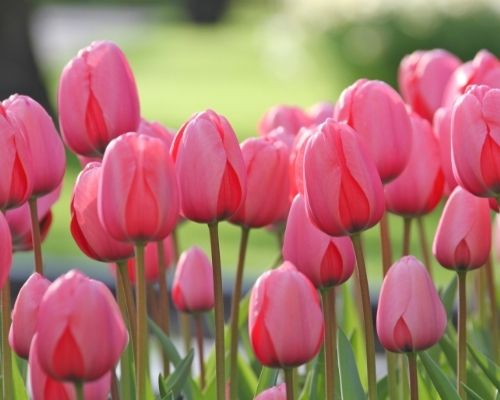Your Guide to Planning, Planting, and Growing Tulips
Tulips are the most colorful of all spring flowers. They are also one of the easiest flowers you'll ever grow. Just plant the bulbs in fall for blossoms the following spring.
There are hundreds of beautiful tulips to choose from, in enough colors, shapes, sizes and bloom times to inspire every gardener’s creativity. Whether you plant them in groups of 10 or 1000, tulips always put on an impressive show.
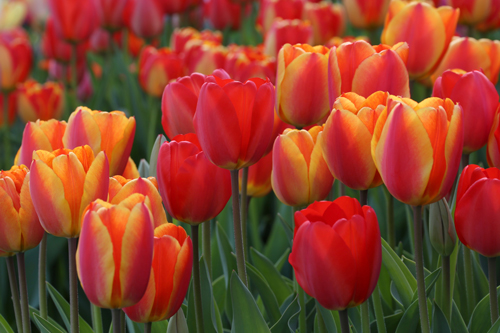
Start with A Better Bulb
When you compare two tulip bulbs side by side, it's easy to see differences in quality. Larger bulbs (as shown at far left) contain more stored food energy and will produce stronger stems and bigger blooms. A healthy tulip bulb should feel firm (not dry or mushy). A small amount of surface mold is normal.
Tulip bulbs are measured in centimeters around the "waist" of the bulb. Longfield Gardens supplies tulip bulbs that are at least 12cm in circumference. This ensures you will always get the biggest, brightest blooms.
Each year's crop of tulip bulbs is a little different, due to weather conditions during the growing season and the late summer harvest. Bulb size also varies by cultivar, with some varieties of tulips naturally producing larger bulbs than others. We purchase the largest, highest quality bulbs possible so you can enjoy a beautiful display of spring flowers.
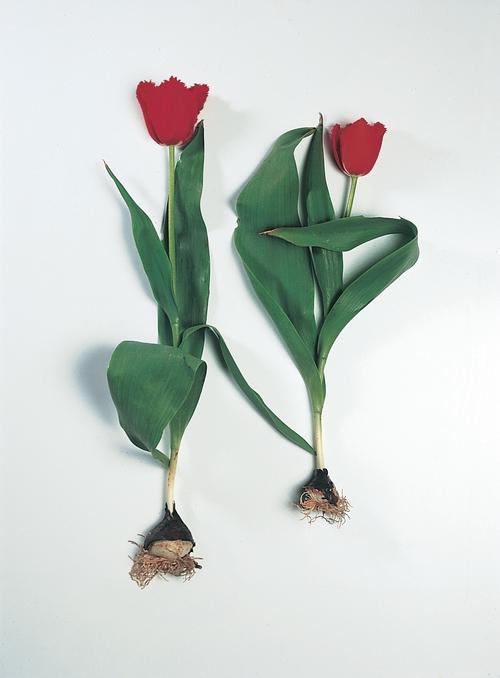
Plan for Success
Sun and Shade: Tulips are remarkably versatile and will grow in sun or part shade.
Hardiness Zone: Tulips perform best in areas with cold winters (growing zones 3-7). If you live in zone 8 or warmer, read How to Grow Spring Bulbs in Warm Climates. To find which hardiness zone you live in, consult the USDA Hardiness Zone Map HERE.
Soil Conditions: Tulips should be planted in good soil that is well-drained and never soggy. Peat moss or compost may be added to help improve drainage. In areas with heavy soil, consider planting tulips in raised beds.
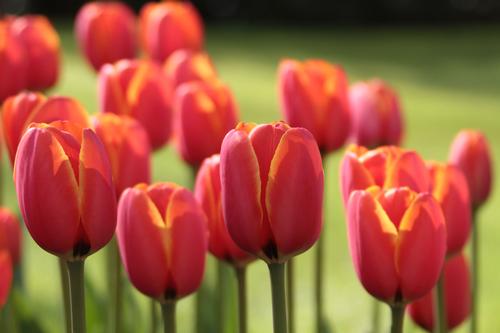
Where to Plant Tulips
Entryways and Borders: Tulips will fill your yard with color long before most other plants have emerged from their winter sleep. Create a warm welcome by planting a bed of tulips along your front walk or in front yard flower beds.
Cut Flower Gardens: Enjoy the fun of arranging bouquets of tulips for your home or to share with friends. Planting tulip bulbs in a cutting garden makes it easy to bring the freshness of spring indoors.
Curb Appeal: Tulips look great in mass plantings and will attract the admiring eyes of everyone who passes by. The more tulips you plant, the better the show.
Containers and Windowboxes: In the fall, you can replace summer annuals with tulip bulbs. Greigii tulips and double early tulips are especially good for containers. The bulbs will sleep through the winter months and deliver a burst of spring color long before you're ready to begin planting.
In growing zones 6-8, planters may be left outdoors for the winter as long as the soil doesn't get too wet. In colder areas, container-grown bulbs must be protected from extreme cold. Learn more here: How to Grow Spring Bulbs in Containers.
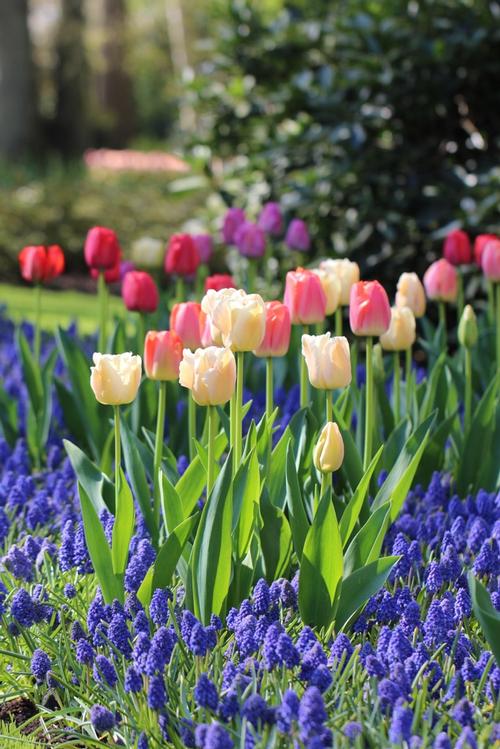
Use our Tulip Planning Guide to extend the season with early, mid and late season tulips. Be sure your garden also includes early-blooming bulbs such as hyacinths, daffodils, muscari and scilla. And don't forget alliums. They come into flower just after the tulips, bridging the gap between spring bulbs and early summer perennials.
Consider underplanting your tulips with low-growing spring bulbs such as anemone blanda and muscari. Pansies, violas and other cold-tolerant annuals are excellent companions for tulips. For perennials, consider primroses, dicentra, hosta and pulmonaria.
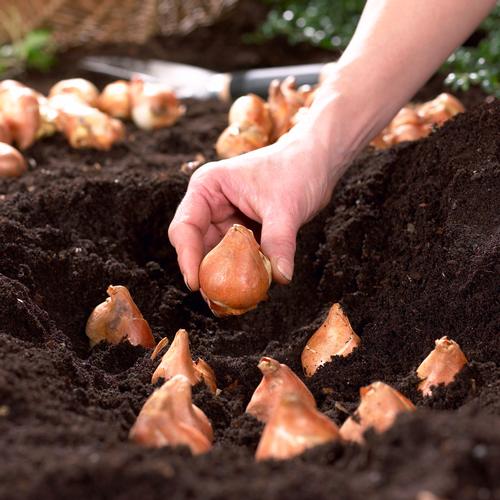
How to Plant Tulips
When to Plant: Tulip bulbs should be planted in mid to late fall, any time after the first frost and before the ground freezes. For best results, plant the bulbs within a month after you receive them.
Depth and Spacing: Plant tulip bulbs 6" to 8" deep and 4" to 5" apart on center. You may plant the bulbs individually, or can dig out a larger area and plant a number of bulbs at once. Position the bulbs with the pointy end up and then cover them with soil. Fall and winter rains usually provide adequate moisture. Water only if the weather is very dry.
Planting Tips: Planting tulips side by side in a single row tends to look stiff and unnatural. For best results, plant informal groups of 7 or more bulbs. Rectangular, triangular or oval patterns will make the planting look as full as possible and ensure the flowers are visible from all angles.
To watch our video about How to Plant Tulip Bulbs, click HERE.
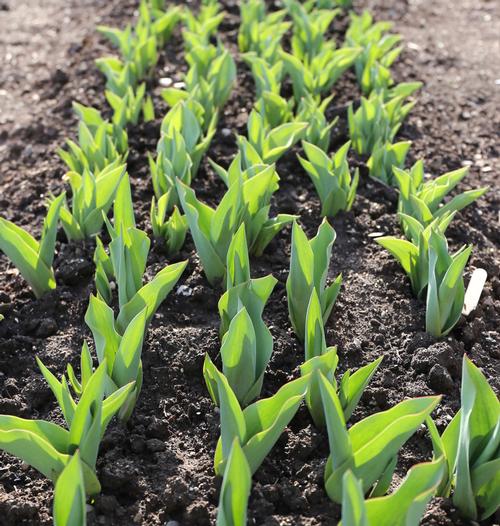
What to Expect in Spring
Tulip bulbs develop roots in the fall and then go dormant until early spring. Depending where you live, you can expect leaves to start emerging from the soil as early as February or as late as May. Early-blooming varieties will appear sooner than late-blooming varieties.
The first thing you will see is the tips of the pointed leaves. Tulip foliage is very cold hardy and not harmed by snow or freezing temperatures. The flower buds usually stay under ground until the leaves are about 7" tall. As the plant continues to grow, the stem gets taller and the buds gradually get larger and begin to show color. Tulips usually bloom 4-5 weeks after you see the first green shoots.
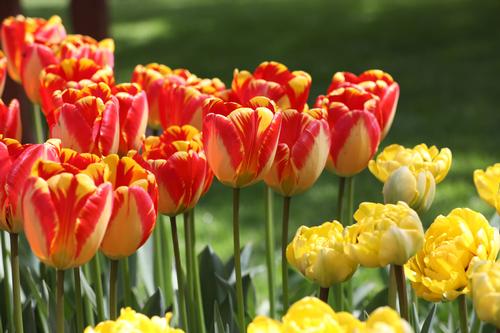
Caring for Tulips After they Flower
Will your tulips come back to bloom again next year? This depends on the type of tulip you planted and the growing conditions in your garden. If the bulbs do produce a second year of flowers, you can expect the blossoms to be smaller and fewer in number. The best way to guarantee an impressive display of tulips every spring is to plant fresh bulbs each fall.
Treating your tulips as annuals lets you experiment with new colors and flower styles, and compose your own unique display of spring color. You can also feel free to cut your tulips for arrangements and enjoy nice long stems with plenty of foliage. After the flowers fade, just dig up and discard the plants, bulb and all.
If you'd rather try for a second year of flowers, here are some tips:
- Choose Darwin hybrids, Emperor or species tulips. These bulbs are more likely to re-bloom.
- Plant your tulip bulbs in a sunny spot with very well drained soil. In moist soil, tulip bulbs tend to split and lose their ability to re-bloom.
- Immediately after flowering, snap off the spent flower heads. This will prevent the plant from trying to produce seeds.
- Allow the stems and foliage to continue growing until they turn yellow. During this time, the plant is producing energy for next year's flowers.
- Once the foliage is completely limp, you can remove it with a gentle tug or simply cut it back to the ground.
Tulips may be pre-ordered starting in May and are available for purchase through November. For best selection, reserve your bulbs during spring or summer for shipping in fall at the proper planting time for your growing zone. To see our complete selection of tulips click HERE.

